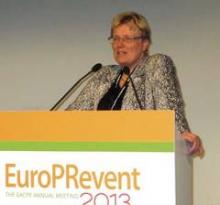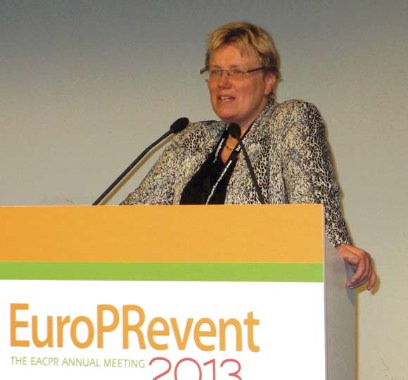User login
ROME – The European Society of Hypertension is poised to endorse low-dose aspirin prophylaxis against preeclampsia for a large percent of pregnant women, according to a report at the annual meeting of the *European Association for Cardiovascular Prevention and Rehabilitation.
Endorsement of aspirin treatment for prophylaxis of preeclampsia in moderate- and high-risk women is part of new guidelines for managing hypertension prepared jointly by the European Society of Hypertension (ESH) and the European Society of Cardiology that will be unveiled at the hypertension society’s annual meeting in Milan in June, Dr. Renata Cifková said at the meeting.
"Aspirin, at a dosage of 75 mg/day, is recommended for the prevention of preeclampsia in women at high or moderate risk of preeclampsia from 12 weeks’ gestation until delivery," said Dr. Cifková, professor and head of the department of preventive cardiology at Thomayer University Hospital in Prague. The high- and moderate-risk categories together define a large proportion of women who become pregnant today.
The new guidelines define women at high risk who should receive aspirin prophylaxis as those who had gestational hypertension during a prior pregnancy, or women with chronic kidney disease, an autoimmune disease such as systemic lupus erythematosus or antiphospholipid syndrome, type 1 or 2 diabetes, or chronic hypertension. The guidelines also say that women should receive aspirin prophylaxis if they have two or more of these moderate-risk factors for preeclampsia: first pregnancy, age 40 years or older, a prior pregnancy interval of more than 10 years, a body mass index of 30 kg/m2 or greater, a family history of preeclampsia, or a multiple pregnancy.
These new ESH guidelines for preeclampsia prevention with aspirin follow exactly the recommendations made in August 2010 by the U.K.’s National Institute for Health and Clinical Excellence (NICE), noted Dr. Cifková. The most notable evidence supporting this approach came from a meta-analysis published in 2010 that included 27 studies involving more than 11,000 women and found that low-dose aspirin begun early in pregnancy cut the incidence of preeclampsia by about 50% (Ob.Gyn. 2010;116:402-14).
Another soon-to-appear guidance from the ESH, on appropriate patients for ambulatory blood pressure monitoring (ABPM), received a preview from Dr. Gianfranco Parati, professor of cardiovascular medicine at the University of Milan.
The new revision comes from an expert panel first convened 2 years ago by the ESH, Dr. Parati said at the meeting. The soon-to-be-published position on ABPM will not make recommendations that are as well defined as the ones for preeclampsia prophylaxis. "Is ABPM needed for every patient with hypertension? No, but it should be used in more patients," he said. Routine use of ABPM to confirm hypertension in all patients "is not suitable for every country because of its cost," he added.
Nonetheless, the new ESH consensus statement calls for using ABPM to confirm a diagnosis of hypertension or its absence, and thereby better avoid the twin nemeses of accurate hypertension assessment: white coat hypertension and masked hypertension, he said. ABPM also allows assessment of blood pressure control throughout 24 hours. The new guidelines say that ABPM is appropriate for selected elderly, children, and adolescent patients, and during pregnancy.
When high-risk patients or patients with nocturnal hypertension undergo ABPM, a follow-up, repeat examination should be done in 6 months. In most other patients, follow-up ABPM can occur after 1-2 years, Dr. Parati said.
Dr. Cifková reported no relevant financial disclosures. Dr. Parati has received honoraria from Bayer, Boegringer Ingelheim, Daiichi-Sankyo, Merck Serono, Menarini, Novartis, Recordati, Sanofi Aventis, and Takeda, and research support from Boehringer Ingelheim, Bayer, and Sanofi Aventis.
On Twitter @mitchelzoler
*Correction (5/29/13): A previous version of this story misstated the meeting name during which these presentations were made. This version has been updated.
ROME – The European Society of Hypertension is poised to endorse low-dose aspirin prophylaxis against preeclampsia for a large percent of pregnant women, according to a report at the annual meeting of the *European Association for Cardiovascular Prevention and Rehabilitation.
Endorsement of aspirin treatment for prophylaxis of preeclampsia in moderate- and high-risk women is part of new guidelines for managing hypertension prepared jointly by the European Society of Hypertension (ESH) and the European Society of Cardiology that will be unveiled at the hypertension society’s annual meeting in Milan in June, Dr. Renata Cifková said at the meeting.
"Aspirin, at a dosage of 75 mg/day, is recommended for the prevention of preeclampsia in women at high or moderate risk of preeclampsia from 12 weeks’ gestation until delivery," said Dr. Cifková, professor and head of the department of preventive cardiology at Thomayer University Hospital in Prague. The high- and moderate-risk categories together define a large proportion of women who become pregnant today.
The new guidelines define women at high risk who should receive aspirin prophylaxis as those who had gestational hypertension during a prior pregnancy, or women with chronic kidney disease, an autoimmune disease such as systemic lupus erythematosus or antiphospholipid syndrome, type 1 or 2 diabetes, or chronic hypertension. The guidelines also say that women should receive aspirin prophylaxis if they have two or more of these moderate-risk factors for preeclampsia: first pregnancy, age 40 years or older, a prior pregnancy interval of more than 10 years, a body mass index of 30 kg/m2 or greater, a family history of preeclampsia, or a multiple pregnancy.
These new ESH guidelines for preeclampsia prevention with aspirin follow exactly the recommendations made in August 2010 by the U.K.’s National Institute for Health and Clinical Excellence (NICE), noted Dr. Cifková. The most notable evidence supporting this approach came from a meta-analysis published in 2010 that included 27 studies involving more than 11,000 women and found that low-dose aspirin begun early in pregnancy cut the incidence of preeclampsia by about 50% (Ob.Gyn. 2010;116:402-14).
Another soon-to-appear guidance from the ESH, on appropriate patients for ambulatory blood pressure monitoring (ABPM), received a preview from Dr. Gianfranco Parati, professor of cardiovascular medicine at the University of Milan.
The new revision comes from an expert panel first convened 2 years ago by the ESH, Dr. Parati said at the meeting. The soon-to-be-published position on ABPM will not make recommendations that are as well defined as the ones for preeclampsia prophylaxis. "Is ABPM needed for every patient with hypertension? No, but it should be used in more patients," he said. Routine use of ABPM to confirm hypertension in all patients "is not suitable for every country because of its cost," he added.
Nonetheless, the new ESH consensus statement calls for using ABPM to confirm a diagnosis of hypertension or its absence, and thereby better avoid the twin nemeses of accurate hypertension assessment: white coat hypertension and masked hypertension, he said. ABPM also allows assessment of blood pressure control throughout 24 hours. The new guidelines say that ABPM is appropriate for selected elderly, children, and adolescent patients, and during pregnancy.
When high-risk patients or patients with nocturnal hypertension undergo ABPM, a follow-up, repeat examination should be done in 6 months. In most other patients, follow-up ABPM can occur after 1-2 years, Dr. Parati said.
Dr. Cifková reported no relevant financial disclosures. Dr. Parati has received honoraria from Bayer, Boegringer Ingelheim, Daiichi-Sankyo, Merck Serono, Menarini, Novartis, Recordati, Sanofi Aventis, and Takeda, and research support from Boehringer Ingelheim, Bayer, and Sanofi Aventis.
On Twitter @mitchelzoler
*Correction (5/29/13): A previous version of this story misstated the meeting name during which these presentations were made. This version has been updated.
ROME – The European Society of Hypertension is poised to endorse low-dose aspirin prophylaxis against preeclampsia for a large percent of pregnant women, according to a report at the annual meeting of the *European Association for Cardiovascular Prevention and Rehabilitation.
Endorsement of aspirin treatment for prophylaxis of preeclampsia in moderate- and high-risk women is part of new guidelines for managing hypertension prepared jointly by the European Society of Hypertension (ESH) and the European Society of Cardiology that will be unveiled at the hypertension society’s annual meeting in Milan in June, Dr. Renata Cifková said at the meeting.
"Aspirin, at a dosage of 75 mg/day, is recommended for the prevention of preeclampsia in women at high or moderate risk of preeclampsia from 12 weeks’ gestation until delivery," said Dr. Cifková, professor and head of the department of preventive cardiology at Thomayer University Hospital in Prague. The high- and moderate-risk categories together define a large proportion of women who become pregnant today.
The new guidelines define women at high risk who should receive aspirin prophylaxis as those who had gestational hypertension during a prior pregnancy, or women with chronic kidney disease, an autoimmune disease such as systemic lupus erythematosus or antiphospholipid syndrome, type 1 or 2 diabetes, or chronic hypertension. The guidelines also say that women should receive aspirin prophylaxis if they have two or more of these moderate-risk factors for preeclampsia: first pregnancy, age 40 years or older, a prior pregnancy interval of more than 10 years, a body mass index of 30 kg/m2 or greater, a family history of preeclampsia, or a multiple pregnancy.
These new ESH guidelines for preeclampsia prevention with aspirin follow exactly the recommendations made in August 2010 by the U.K.’s National Institute for Health and Clinical Excellence (NICE), noted Dr. Cifková. The most notable evidence supporting this approach came from a meta-analysis published in 2010 that included 27 studies involving more than 11,000 women and found that low-dose aspirin begun early in pregnancy cut the incidence of preeclampsia by about 50% (Ob.Gyn. 2010;116:402-14).
Another soon-to-appear guidance from the ESH, on appropriate patients for ambulatory blood pressure monitoring (ABPM), received a preview from Dr. Gianfranco Parati, professor of cardiovascular medicine at the University of Milan.
The new revision comes from an expert panel first convened 2 years ago by the ESH, Dr. Parati said at the meeting. The soon-to-be-published position on ABPM will not make recommendations that are as well defined as the ones for preeclampsia prophylaxis. "Is ABPM needed for every patient with hypertension? No, but it should be used in more patients," he said. Routine use of ABPM to confirm hypertension in all patients "is not suitable for every country because of its cost," he added.
Nonetheless, the new ESH consensus statement calls for using ABPM to confirm a diagnosis of hypertension or its absence, and thereby better avoid the twin nemeses of accurate hypertension assessment: white coat hypertension and masked hypertension, he said. ABPM also allows assessment of blood pressure control throughout 24 hours. The new guidelines say that ABPM is appropriate for selected elderly, children, and adolescent patients, and during pregnancy.
When high-risk patients or patients with nocturnal hypertension undergo ABPM, a follow-up, repeat examination should be done in 6 months. In most other patients, follow-up ABPM can occur after 1-2 years, Dr. Parati said.
Dr. Cifková reported no relevant financial disclosures. Dr. Parati has received honoraria from Bayer, Boegringer Ingelheim, Daiichi-Sankyo, Merck Serono, Menarini, Novartis, Recordati, Sanofi Aventis, and Takeda, and research support from Boehringer Ingelheim, Bayer, and Sanofi Aventis.
On Twitter @mitchelzoler
*Correction (5/29/13): A previous version of this story misstated the meeting name during which these presentations were made. This version has been updated.
AT EUROPREVENT 2013


